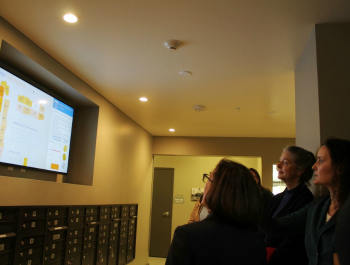Image

Jessica Woodruff, Director of Housing Development, REACH Community Development
Challenge: Hillsboro is Oregon’s fifth largest city, home to rapidly growing high tech and health care industries. Over the past 15 years, several thousand housing units around Hillsboro’s Orenco Station, also known as “Silicon Forest” have been mostly high-priced luxury homes. Workers with incomes under $30,000 a year can’t afford them.
Hillsboro is Oregon’s fifth largest city and is enjoying a boon of rapidly growing high tech and health care industries that support high wage jobs. Orenco Station is an area of Hillsboro nationally recognized as a model of new urbanism. Over the past 15 years, several thousand housing units have been built in and around Orenco Station, also known as “Silicon Forest.”
The growth, however, has focused on market-rate and luxury living. Workers with incomes under $30,000 a year can’t afford the new units. The majority of the remaining land in the area is under development for approximately 1,000 additional luxury units with rents that are among the highest in the city.
In 2013, REACH set out to secure an affordable housing site in the Orenco Station neighborhood of Hillsboro. We took a three pronged approach:
- Select a transit-oriented site to lower transportation costs
- Build affordable units for households making 50 percent of average median income, or less and
- Use Passive House standard construction to dramatically reduce monthly utility bills.
The Passive House standard is an established rating system designed to measure efficiency. It is granted only by third party verification after construction is complete.
June 29, 2015, marked the opening of Orchards at Orenco Phase 1, a thriving community, and the largest certified multi-family Passive House building in North America. The development consists of 40 one-bedroom and 17 two-bedroom units. The building will achieve nearly 90 percent energy reduction for heating, and 60 to 70 percent for overall energy use, compared to a comparable USGBC LEED building. Other benefits include improved indoor air quality provided by the continuous ventilation; better comfort in the units; improved construction quality, reducing the risk of moisture intrusion; and reduction of noise from the adjacent light rail line.
Orchards' super-insulated foundation, walls and roof dramatically reduce heating and cooling loads, and therefore the size and expense of the equipment that provide it. In addition, REACH installed the ImagineEnergy system to track and improve upon residents’ energy usage habits. All of this benefits residents, who save an estimated $30 to $45 per month, per unit, a 1 to 2 percent increase in their annual income.
 Orchards has earned national acclaim, by showing Passive House construction— traditionally available only at middle and upper incomes— can work for lower income families as well.
Orchards has earned national acclaim, by showing Passive House construction— traditionally available only at middle and upper incomes— can work for lower income families as well.“Every day I find a new reason to love it,” says Orchards resident Georgye Hamlin. “It’s cool, it’s quiet, and I don’t even hear the train.”
Additionally, the Transit Oriented Location has proven a resounding success. Due to the suburban location, local government was skeptical tenants would choose public transportation. We thought differently, and now have data to advocate for more efficient parking requirements at affordable transit-oriented developments. The local zoning required 1.5 parking spaces per unit. REACH sought a parking reduction variance to 0.8 and the city approved 1.0. Although city regulations required 57 parking spaces, our independent traffic study shows tenants use parking at a ratio of 0.65.
REACH learned several key lessons from this project:
- Get buy-in from all critical team members: the architect, general contractor, structural engineer, construction consultant and Passive House consultant.
- Learn from those who have worked on similar projects, and share with others trying to achieve similar goals.
- Educate staff and tenants early and often about Passive House construction.
As with all innovative endeavors, we initially faced many risks and unknowns. But the success of this project, and the positive response from residents, has spurred us to build another 58-unit Passive House building adjacent to Orchards at Orenco, scheduled to open in June 2016. We believe we are on a path to a cost-effective model for high efficiency affordable apartments to use across our region, and we hope to continue our work.

